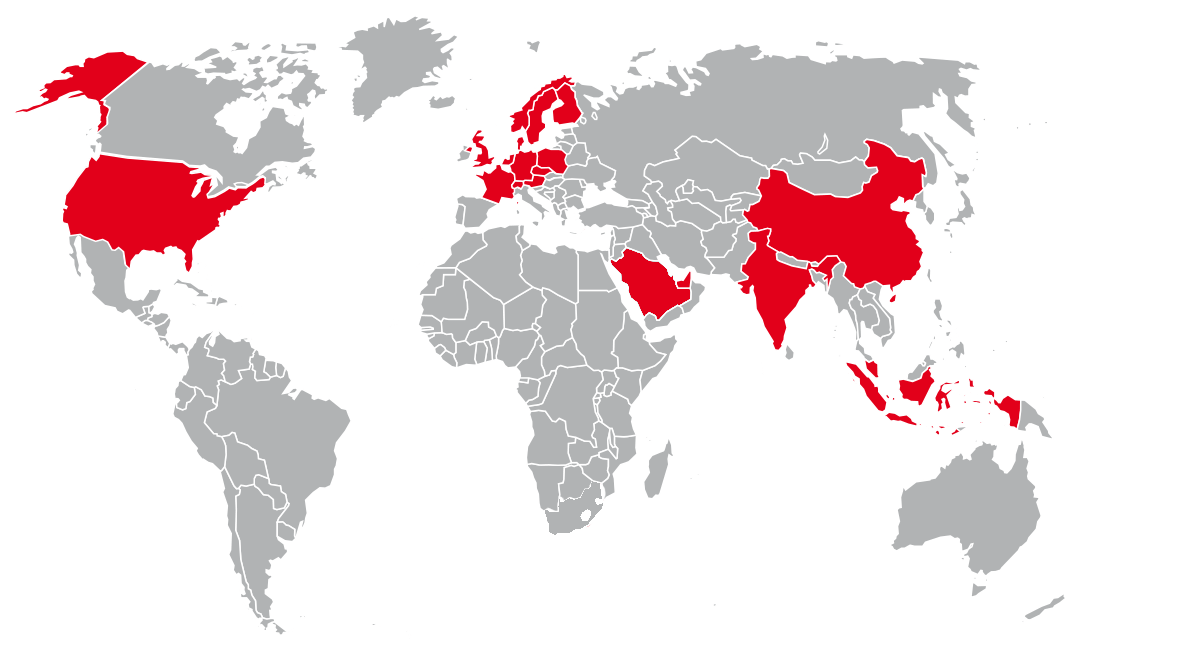
Barrial self supporting
The flat roof has become an important resource: Available flat roof areas increasingly serve as usable spaces in the form of greened flat roof terraces and as locations for e.g. building services, air conditioning, lightning protection and solar systems. As a further possible use, escape and rescue routes can be routed over the roof. This extension leads to the creation of new workplaces there for regularly required maintenance, repair, care or snow removal work. This is accompanied by additional requirements in terms of occupational health and safety .
Safety is the top priority on flat roofs. It is not only about collective protection for the users at any time of the day or night, but also about the tightness of the roof cladding. Within the framework of a long-standing partnership, Carl Stahl and dani alu offer custom-fit solutions for all aspects of reliable fall protection on flat roofs. The basic principle for modern prevention is that permanent, collective protective measures (e.g. guardrails) have clear legal priority over individual protective measures (e.g. PPE) in order to prevent fall accidents.
The railing systems of the Barrial® series can be installed in a load-bearing manner, i.e. without penetrating the waterproofing, or in a fixed manner with a wide range of fastening options on concrete or a metal roof, depending on the individual requirements and wishes of the project.
No off-the-peg railing: Depending on the object and its conditions, the selected installation area and specific requirements from the different layer structures of the waterproofing complexes, special technical and optical requirements arise. Based on many years of experience in the field of connection and termination technology for waterproofing as well as safety-related collective protection measures for flat roofs, dani alu creates individual solution concepts. The simple assembly of the modular and compatible system components as well as the flexible adjustability for level and height compensation are particularly appreciated in practice.
Planning and execution in an "all-round carefree package
For more than 40 years, dani alu has been a system supplier for technically high-quality and visually appealing solutions made of aluminum for safe working and more beautiful living on flat roofs. With regard to liability and warranty issues, the protection of the sensitive waterproofing is of particular importance. Therefore, self-supporting structures and railings as a supplement to the proven fixed-mounted solutions have been a focus of our activities for years.
As experts
in the field of flat roof safety, we at Carl Stahl, together with our partner,
offer you competent support from hazard analysis, measurement, object-related
conceptual design of safety-related equipment and detailed planning to
installation service.
Barrial fixed, foot A / Industry

Barrial® fix - A good solution with safety. Whether at the roof workplace, on machines and equipment, ramps or platforms - safety is an important issue everywhere in industry. Missing or inadequate fall protection and barriers are a frequent cause of often serious injuries. The legal regulations and requirements of the employers' liability insurance associations are now very clear. With the aluminum railing systems of dani alu the legal requirements and specifications of the workplace directive can be fulfilled in an optimal way. Whether on the facade, the parapet inside, on the parapet or on the roof surface made of concrete or a metal roof solution - Based on many years of experience in the field of connection and termination technology for waterproofing as well as safety-related collective protection measures for flat roofs, the most diverse installation areas can be served quickly and individually with only a few modular system components!
Barrial metal roof

Barrial®
Metal Roof - Safe all around, 24/7! Whether sandwich, standing seam, flanged
seam or flat roofs with metal roof support shells, the modular
railing
systems from dani alu
offer tried and tested solutions for the most diverse
roof variants. With the well thought-out metal roof systems, the right
technical connection for collective fall protection can be found for every
roof.
Barrial shed roof

Barrial® Shed Roof - Solved with safety. With its special shape, the shed roof is reminiscent of the saw teeth of a saw. The roof shape is well suited for the implementation of large roof areas, e.g. for workshops, sports or logistics halls, and provides them with sufficient indirect daylight via the generous glass fronts. The roof elements are known to be permanently exposed to weather and gravity. At the latest with the combination of solar elements, the shed roof also becomes a regular workplace for maintenance and repair work. The railing system Barrial® by dani alu offers optimal protection against falling through the glass elements at any time.
Barrial corridor

Barrial® Corridor - certainly a good way to go. From what used to be the pure envelope of a building, the flat roof is becoming increasingly important in view of fire protection. As a result of the conversion of buildings, the construction of existing buildings or corresponding requirements in new buildings, the necessary escape and rescue routes are systematically routed over the flat roof as part of the fire protection concept. However, mistakes with far-reaching consequences can quickly occur during the planning stage if the complex topic is not considered holistically from the outset. The load-bearing Barrial® corridor systems from dani alu are installed on the roof surface without penetration. In conformity with standards and certified, you move safely in the field of tension of the legal requirements.
Barrial skylight dome defense

Collective protection as a solution - how to implement it properly? A short consulting guide.
Flat roof areas increasingly serve as utility spaces (e.g., technical equipment, air conditioning, lightning protection, solar systems) and living spaces (e.g., landscaped flat roof terraces, oases of well-being). Thus, jobs are created there due to regularly required maintenance, repair and care work. This means that occupational health and safety requirements must be complied with.
In very simplified terms, "protection against falls is always required when a hazard exists" . For the determination and assessment of the object-specific hazards that are associated with their work for the employees, at least the following criteria must be taken into account (excerpt from technical rules for workplaces ASR A2.1):
- Crash height,
- Type and duration of activity, physical stress,
- Distance from the edge of the fall,
- Condition of the stand (angle of inclination) or the standing surface (e.g. slip resistance),
- Nature of the lowered surface, e.g., bulk materials or water (sinking, smothering/drowning), concrete (hard impact), rebar connections (impaling), objects or machinery
- Condition of the working environment and hazardous external influences, e.g. poor/restricted visibility, vibrations, factors affecting balance, weather influences (e.g. wind, ice and heavy snowfall).
If an accident occurs, many parties involved bear the legal responsibility: from the building owner and operator to safety specialists and janitors - the chain of responsibility is long, regardless of the socio-political consequences! It should be noted that occupational health and safety does not know any protection of the status quo!
Laws, regulations, codes of practice - there are numerous requirements on the subject of occupational health and safety, regulated, for example, in
- Occupational Safety and Health Act §4
- Workplace ordinance, ASR
- Building regulations
- Construction Site and Industrial Safety Ordinance
- Technical rules for operational safety, TRBS 2121
- Accident prevention regulations
- Technical standards
- DIN 4426 for the installation and maintenance of structural facilities
- DIN 31051
- DIN EN 13374 Class A
- DIN EN ISO 14122-3
- DIN 18065
In principle:
- Collective hazard protection takes precedence over individual protection measures
- Ranking
according to T-O-P principle: Technical
(e.g. guardrails)
before organizational (e.g. nets as fall arrest equipment)
before personal (e.g. anchor points with rope protection)
- What is required is "state of the art" fall protection, i.e. collective-permanent. The top priority here should be to exclude a fall hazard due to "non-use" or "non-knowledge" right from the start.
The requirements that are placed on the flat roof as a workplace are compiled in tabular form in DGUV 201-056 of BG Bau. The overview shows the minimum requirements , which are influenced by the groups of people who will have access to the roof and the frequency of access (up to permanent use). In connection with these defined minimum requirements, the entire period of use should always be considered during planning and compared in an economic efficiency calculation. Supposedly strong differences in the purchase are invalidated in the second period of use at the latest - compared to a guardrail system with recommended visual inspection every two years, the follow-up costs for documentation, prohibition of working alone, training or maintenance for a personal protection solution must not be underestimated!


















































